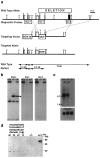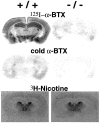Mice deficient in the alpha7 neuronal nicotinic acetylcholine receptor lack alpha-bungarotoxin binding sites and hippocampal fast nicotinic currents
- PMID: 9364063
- PMCID: PMC6573618
- DOI: 10.1523/JNEUROSCI.17-23-09165.1997
Mice deficient in the alpha7 neuronal nicotinic acetylcholine receptor lack alpha-bungarotoxin binding sites and hippocampal fast nicotinic currents
Abstract
The alpha7 subunit of the neuronal nicotinic acetylcholine receptor (nAChR) is abundantly expressed in hippocampus and is implicated in modulating neurotransmitter release and in binding alpha-bungarotoxin (alpha-BGT). A null mutation for the alpha7 subunit was prepared by deleting the last three exons of the gene. Mice homozygous for the null mutation lack detectable mRNA, but the mice are viable and anatomically normal. Neuropathological examination of the brain revealed normal structure and cell layering, including normal cortical barrel fields; histochemical assessment of the hippocampus was also normal. Autoradiography with [3H]nicotine revealed no detectable abnormalities of high-affinity nicotine binding sites, but there was an absence of high-affinity [125I]alpha-BGT sites. Null mice also lack rapidly desensitizing, methyllycaconitine-sensitive, nicotinic currents that are present in hippocampal neurons. The results of this study indicate that the alpha-BGT binding sites are equivalent to the alpha7-containing nAChRs that mediate fast, desensitizing nicotinic currents in the hippocampus. These mice demonstrate that the alpha7 subunit is not essential for normal development or for apparently normal neurological function, but the mice may prove to have subtle phenotypic abnormalities and will be valuable in defining the functional role of this gene product in vivo.
Figures




References
-
- Albuquerque EX, Alkondon M. Initial characterization of the nicotinic acetylcholine receptors in rat hippocampal neurons. J Recept Res. 1991;11:1001–1021. - PubMed
-
- Alkondon M, Albuquerque EX. Diversity of nicotinic acetylcholine receptors in rat hippocampal neurons. I. Pharmacological and functional evidence for distinct structural subtypes. J Pharmacol Exp Ther. 1993;265:1455–1473. - PubMed
-
- Alonso JR, Amaral DG. Cholinergic innervation of the primate hippocampal formation. I. Distribution of choline acetyltransferase immunoreactivity in the Macaca fascicularis and Macaca mulatta monkeys. J Comp Neurol. 1995;355:135–170. - PubMed
-
- Bertrand D, Changeux J-P. Nicotinic receptor: an allosteric protein specialized for intercellular communication. Neuroscience. 1995;7:75–90.
-
- Broide RS, O’Connor LT, Smith MA, Smith JAM, Leslie I. Developmental expression of α7 neuronal nicotinic receptor messenger RNA in rat sensory cortex and thalamus. Neuroscience. 1995;67:83–94. - PubMed
Publication types
MeSH terms
Substances
Grants and funding
LinkOut - more resources
Full Text Sources
Other Literature Sources
Molecular Biology Databases
Research Materials
